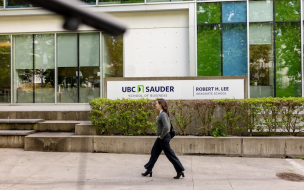The new one-year degree would provide a quick route to management careers, and allow Goizueta to funnel graduates into the cadre of companies under the Consortium’s banner – including Bank of America and Goldman Sachs.
More importantly, the beefed-up version of its original MBA course would give the school lease to test a new learning model which would sweep its way across the United States.
“We are pleased to extend our alliance to include the one-year MBA program... which will enable Goizueta one-year students to take advantage of Consortium recruiting and fellowship opportunities, while completing their studies and returning to the work force in just one year,” enthused Dean Larry at the time, in 2011.
Since then, a plethora of top-ranking US schools have rolled out shortened versions of their revered MBA programs. It is part a bid to scoop up candidates who are under increasing pressure to return to the workforce sooner rather than later, but that has not always been the case.
Americans still have great confidence in the two-year model, and international candidates for whom the US is still the first-choice destination share the enthusiasm.
Alejandro Correa, a Mexican MBA graduate of Chicago Booth’s two-year MBA, says: “The job market is more meritocratic and the work culture is more horizontal than it is back home, so coming to the US is a great option in terms of career development.”
But there are signs that one-year market is finally beginning to stir. Streamlined programs are gaining ground with cost and time-conscious students.
This has spurred business schools to adapt, partly in response to falling two-year applications, and stagnant figures for US citizens taking the GMAT – the entry test to most MBA programs.
The Graduate Management Admissions Council says that there are now 189 one-year MBA programs, compared to 173 four years ago.
Cornell recently launched a one-year MBA program based in New York, snapping up 55 candidates. Nearly 50% of students in 2014's class are from outside America.
Kellogg School of Management plans to double the size of its one-year MBA program, after reporting that applications increased 6%, and applications to the two-year MBA fell 7%.
The increase in programs is buoyed by more candidates who are willing to try these new-fangled programs. Enrolment rates for Goizueta’s one-year course have shot up 26% over the past year.
GMAC says 55% of all one-year programs have reported increases in applications during the same period.
One-year MBA students in the US typically start in May, and absorb a year’s worth of study in just four months. In September, they will likely begin learning with the school’s two-year MBA students and take elective classes.
Increased interest is being driven by lower tuition fees and compensation of taking time out of full-time work, as you will only be paying for half of a typical degree’s length of study.
Yet Goizueta bills its one-year tuition at about $72,000 – more expensive than the $48,000 two-year tuition. But living costs on the accelerated program are significantly cheaper – and 12-month MBAs will have made a year’s salary by the time the other cohort graduates.
Twelve months is the typical length of a program – but some American schools have developed shorter programs. Florida-based Hough Graduate School of Business, for example, offer a 10-month MBA for students who have graduated with an undergraduate business degree within the past seven years.
Hawks will argue that the pace of the degree is not suitable for most candidates, and there are issues with Hough’s lack of candidate work experience – a key component of most MBA programs.
There are further concerns with the one-year model in America. US schools typically interview during the fall months. One-year MBA candidates will have had about five months’ study, yet they will be competing for MBA jobs with students of two-year programs who have had 15 months’ study.
They will also lack the summer internship opportunity offered mid-way through two-year programs, which are held in high regard in the US.
“In the two-year MBA program, a part of that program that we consider very important is the internship,” says Paul J. Binder, associate director of graduate career services at the Kelly School of Business.
“It really does set them up when they go to full-time positions. It’s a win-win – companies get to see the students in action.”
According to a recent GMAC study, fewer job seekers from one year MBA programs had received early job offers than those on two-year programs – 53% to 61%. Their salary increases were also 9% lower than those on two-year MBA courses.
At Cornell, about 92% of two-year MBA students had landed jobs three months out of graduation in 2012, compared to about 84% of one-year students.
To help compensate for the lack of an internship opportunity, Cornell’s fast-track MBAs can enrol in the management practicum – consulting projects with companies in sectors including finance and pharmaceuticals.
However many international MBAs, which make up about half of most MBA classes, gain degrees in America only to fly home again and search for domestic jobs. “A lot of folks just want to stay here for a couple of years to get the experience and then go back home,” says Alejandro.
It is unclear how these new one-year programs will be assessed by US recruiters. Some commentators argue that it is a greater challenge to complete an MBA in just 12 months.
Yet one-year students can miss out on opportunities to study abroad and network with their peers. For many, the internship is still seen as a key route to a permanent job.
Miriam Park, director of university recruiting for Amazon, says that the company offers MBAs internships of between 11 and 12 weeks.
She refused to disclosure numbers, but says that they want to hire hundreds of MBAs globally. “Our MBA hires have been growing every year for the past five years and we hope to continue that trend.”
“Our internship program generously seeds our on-campus hiring,” she adds.
RECAPTHA :
0b
cd
cf
56








